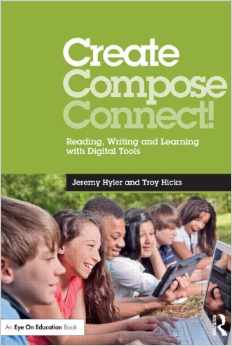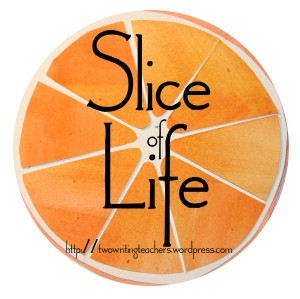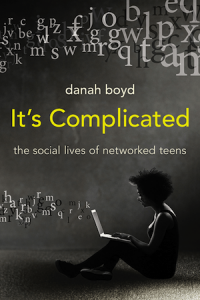
Let me disclose a few things:
- I know a lot of these editors and writers through my connections in the National Writing Project;
- I hung out with the editors in Seattle as they were working on their drafts (and I was working on some resources for the Making Learning Connected MOOC). I knew they were up to something cool, even as they worked in other rooms;
- Last spring, I had only a vague idea of what Connected Learning was (other than I like having connections and I am a big fan of learning … thus, Connected Learning sounded like something I should know about);
- And, finally, I stole a paper copy of this ebook from the table at the Digital Media and Learning Conference when NWP friend Christina Cantrill turned her back. (I am sure she didn’t mind).
All that said, I highly recommend a read of this important collection around teaching and learning.
Teaching in the Connected Learning Classroom is in many ways a classic National Writing Project production through and through: Teachers sharing their classroom experiences (successes and trials) through the lens of inquiry and writing, all viewed through the overarching frame of Connected Learning principles. What are those principles? These ideas emerged from extensive research done by Mimi Ito and others on the ways that young people are learning in this digital age, and center on a few main concepts (better seen in this infographic).
Connected learning is:
- interest-powered
- peer-supported
- academically-orientated
- production-centered
- openly-networked
- shared purpose
Watch this video:
Which is all good and everything but what does that mean for the classroom teacher (like me)? Editor Antero Garcia and the fabulous writers and curators here try to answer that question by focusing the lens on classrooms with stories from teachers grouped around those themes, with curation editors framing those specific stories in the light of inquiry.
“I believe connected learning principles can provide a vocabulary for teachers to reclaim agency over what and how we best meet the individual needs of students in our classroom,” Garcia writes in the introduction. “With learners as the focus, teachers can rely on connected learning as a way to pull back the curtain on how learning happens in schools and agitate the possibilities of classrooms today.”
And so as educator Christopher Working shares how his third graders took blogging to new levels, and how their writing flourished as a result, other teachers (such as Chuck Jurich, Gail Desler, and Danielle Filipiak) explore the dynamics of multimedia production and global audiences and collaboration for student work that goes above and beyond expectation.
“… I was able to see firsthand how centering production afforded opportunities for students to construct affirming identities, make authentic connections to classroom texts, and develop new and specialized technical skill sets,” writes Filipiak, of projects undertaken by her students that merged media and culture together for a social justice message.
Still others are pushing boundaries, even if they are still grounded in literacy. Jason Sellers has his elementary students creating interactive fiction games and stories, mixing in the overarching lessons of programming with the lessons of writing stories. “The unforgiving nature of programming languages was a frustrating but valuable experience for some students, ” Sellars admits. “Small mistakes in a line of code often would render their games unplayable” and yet, lead to revision and iterative design.
One of the more fascinating projects here is the Interactive ‘Zine project, and Christian McKay’s insights into the merging writing, publication and fabrication/maker techniques to create bound collection of writing that has electronic elements built right into the design (with Makey Makey circuit boards and Scratch programming systems). “The Interactive ‘Zine provides opportunities for learners to consciously engage in the creation of their artifact for a public audience, ” writes McKay. “The public entity is developed through the written word that the students share — at a minimum, within the classroom, and more broadly, through public sharing of their Scratch projects at the Scratch website.”
There’s more, much more, that I could share here, but I think you’d be best to get your own copy. And you won’t need to pilfer it from the table off an unsuspecting friend, as I did. Teaching in the Connected Learning Classroom is a free PDF and a relatively cheap ebook for Kindle right now. It is published through the Digital Media and Learning Hub.
Oh, did I mention that just about every article here has a link to a media resource at the National Writing Project’s Digital Is site? That alone is worth the free price of admission. Links are embedded right into the ebook itself, allowing you to see student samples and teacher resources and more, so what are you waiting for? Get connecting.
Peace (in the book),
Kevin
 I wrote up a review of Troy Hicks and Jeremy Hyler’s new book at MiddleWeb: Create Compose Connect (Reading, Writing, and Learning with Digital Tools). I find the book useful in a lot of ways, particularly as it shows ways to enhance learning with technology with some specific projects.
I wrote up a review of Troy Hicks and Jeremy Hyler’s new book at MiddleWeb: Create Compose Connect (Reading, Writing, and Learning with Digital Tools). I find the book useful in a lot of ways, particularly as it shows ways to enhance learning with technology with some specific projects.








